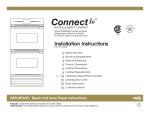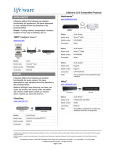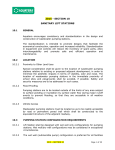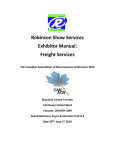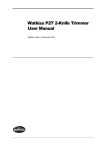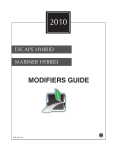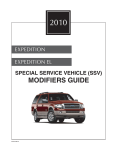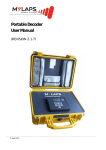Download Connect IO PS302SS00 Service manual
Transcript
Models: PS302SS00 / PS302SS01 / PS301SS00 / PS301SS01 SERVICE MANUAL PS302SS00 PS302SS01 PS301SS00 PS301SS01 © 2006 TMIO, LLC • +1.800.881.TMIO (8646) • www.tmio.com • 1220A Flynn St. • Chattanooga, TN 37403 USA Connect Io Service Manual THE CONNECT IO SERVICE MANUAL CONTAINS INFORMATION THAT IS NECESSARY FOR SERVICING THE TMIO INTELLIGENT OVEN MODELS: PS302SS00 / PS302SS01 PS301SS00 / PS301SS01 THIS MANUAL IS DESIGNED TO BE USED BY QUALIFIED SERVICE PERSONNEL ONLY. DUE TO THE COMPLEXITY AND THE RISK OF HIGH VOLTAGE ELECTRICAL SHOCK, IT IS NOT RECOMMENDED CONSUMERS PREFORM SERVICE ON THIS PRODUCT. Previous data plate location Current data plate location Table of Contents Data Plate Location ............................................................................................................... 2 TMIO Warranty ...................................................................................................................... 4 Section 1 Component Locations............................................................................................ 5 Section 2 Trim, Covers, and Door.......................................................................................... 9 Removing SideTrim.......................................................................................................... 10 Removing Electronic Enclosure Covers .......................................................................... 13 Removing Rear Covers.................................................................................................... 15 Removing Doors.............................................................................................................. 17 Section 3 Electronic Controls................................................................................................ 18 Removing SBC (Single Board Computer)........................................................................ 19 Removing ERC................................................................................................................. 22 Removing Power Boards.................................................................................................. 25 Removing Power Supply................................................................................................... 29 Removing Meat Probe Jack............................................................................................. 32 Removing TOD (Thermal Operating Device)................................................................... 36 Removing Oven Sensor................................................................................................... 38 Removing LCD Touch Screen ......................................................................................... 40 Removing Speaker .......................................................................................................... 45 Removing Light Transformer............................................................................................ 48 Section 4 Fans & Motors....................................................................................................... 51 Removing Damper Motor ................................................................................................ 52 Removing Convection Motor............................................................................................ 59 Removing Cooling Fan Motor........................................................................................... 64 Removing Door Lock Motor.............................................................................................. 67 Section 5 Refrigeration System............................................................................................. 74 Removing Built-in Refrigeratrion System......................................................................... 75 Removing Slide-in Refrigeration System ........................................................................ 80 Section 6 Heating Elements.................................................................................................. 83 Removing Convection Element........................................................................................ 84 Removing Broil Element................................................................................................... 86 Unit Safety Guidelines after Service...................................................................................... 88 “Connect Io” REFRIGERATOR-OVEN WARRANTY FULL TWO-YEAR WARRANTY For two years from the date of purchase, when this appliance is operated and maintained in accordance with the instructions furnished with this product, TMIO, LLC will pay for replacement parts and repair labor to correct defects in materials or workmanship. Service must be provided by a TMIO, LLC designated service company. FIVE-YEAR FULL WARRANTY ON SEALED REFRIGERATION PARTS AS LISTED For five years from the date of purchase, when this product is operated and maintained in accordance with the instructions furnished with this product, TMIO, LLC will pay for replacement parts and repair costs to correct defects in materials or workmanship in the sealed refrigeration system. The sealed refrigeration system consists of the compressor, condenser, evaporator, dryer and all connecting tubing. THIRD THROUGH FIFTH YEAR LIMITED WARRANTY From the third through the fifth year from the date of original installation, TMIO, LLC will repair or replace the following parts that prove to be defective in materials or workmanship. Labor to remove and replace defective parts is not covered. TMIO, LLC recommends that you use TMIO, LLC authorized repair persons to perform such services. The following parts are covered: electric heating elements, blower motors, and electronic oven control boards (EOC’s). LIMITATIONS TMIO, LLC will not pay for: 1. Service calls to correct the installation of your appliance, to instruct you how to use your appliance, to replace house fuses or correct house wiring, or to replace owner-accessible light bulbs. 2. Repairs when your appliance is used in other than normal, single-family household use. 3. Pickup and delivery. Your appliance is designed to be repaired in the home. 4. Damage resulting from accident, alteration, misuse, abuse, fire, flood, improper installation, acts of God or use of products not approved by TMIO, LLC. 5. Repairs to parts or systems resulting from unauthorized modifications made to the appliance or the software operating the appliance. 6. Repairs to parts or systems to correct any defect caused by negligence, accident or improper use, maintenance, installation, service or repair. 7. Replacement parts or repair labor costs for units operated outside the United States and Canada. 8. Travel or transportation expenses for customers who reside in remote areas. 9. Any labor costs during the limited warranty period. 10. Stainless Steel doors, panels, and frame repairs beyond 30 days for cosmetic defects . THE REMEDIES DESCRIBED ABOVE FOR EACH WARRANTY ARE THE ONLY ONES WHICH TMIO, LLC WILL PROVIDE, EITHER UNDER THIS WARRANTY OR UNDER ANY WARRANTY ARISING BY OPERATION OF LAW. TMIO, LLC WILL NOT BE RESPONSIBLE OR LIABLE FOR ANY CONSEQUENTIAL OR INCIDENTAL DAMAGES ARISING FROM THE BREACH OF THIS WARRANTY OR ANY OTHER WARRANTY, WHETHER EXPRESS, IMPLIED OR STATUTORY. Some states do not allow the exclusion or limitation of incidental or consequential damages, so this exclusion or limitation may not apply to you. This warranty gives you specific legal rights and you may also have other rights which may vary from state to state. For service questions visit the web at www.tmio.com or call 1-800-881-TMIO (8646). Section 1 Section 1 Component Locations Component Locations Top View Fig. 1 120V Outlet Terminal Blocks RJ45 Jack Top Oven Light Transformer Bottom Oven Light Transformer Top Oven Power Board Power Supply Bottom Oven Power Board ECR Top Oven TOD Bottom Oven TOD Speaker Single Board Computer (SBC) Fig. 2 Component Locations Fig. 3 RJ45 Jack Rear View 120V Outlet Top Oven Cooling Fan Top Oven TOD Top Oven Inlet Damper Motor Top Oven Convection Fan Motor Top Oven Return Damper Motor Bottom Oven Cooling Fan Bottom Oven TOD Bottom Oven Inlet Damper Motor Bottom Oven Convection Fan Motor Bottom Oven Return Damper Motor Component Locations Front View Fig. 4 LCD Touch Screen Top Oven Door Lock Motor Top Oven Oven Sensor Bottom Oven Door Lock Motor Bottom Oven Oven Sensor Refrigeration System Section 2 Section 2 Trim, Covers, and Door Removal Removing Side Trim Tools Required • Phillips (4 way) screwdriver or bit • 1/4” Nutdriver or socket • Standard Pliers • Kevlar gloves and safety glasses are recommended. 10 Removing Side Trim WARNING : Turn off electrical power to oven before servicing. CAUTION : . 2. 3. Sheet metal partscould have sharp edges and corners. Remove (8) screws from side trim. (4) from each side, see (Fig. 1). Pull unit forward to reveal side trim screws on each side. Remove (2) screws from back of control panel as shown in (Fig. 2). Fig. 1 Fig. 2 11 Removing Side Trim WARNING : Turn off electrical power to oven before servicing. CAUTION : . 2. Be careful when handling sheet metal parts could have sharp edges and corners. Starting from the bottom and moving upward remove the (6) screws and spacers from each side trim, see Fig. 3). NOTE: There are two different size spacers on side trim. The top and bottom side trim spacers are thinner. Use free hand to hold trim to prevent from falling. Remove trim from unit and set aside. Fig. 3 12 Removing Electrical Enclosure Cover Tools Required • Phillips (4 way) screwdriver or bit • 1/4” Nutdriver or socket • Standard Pliers • Kevlar gloves and safety glasses are recommended. 13 Removing Electrical Enclosure Cover WARNING : Turn off the electrical power to oven before servicing. CAUTION : . 2. 3. 4. Sheet metal parts could have sharp edges and corners. Ensure electrical power to oven has been shut off. Remove unit from enclosure, see (Removing and Installing Unit in Cabinet). Remove (13) screws from top electrical enclosure cover as shown in (Fig. 4, Fig. 5). Carefully lift cover and remove from unit (Fig. 6). Fig. 4 Fig. 6 Fig. 5 14 Removing the Rear Covers Tools Required • Phillips (4 way) screwdriver or bit • 1/4” Nutdriver or socket • Standard Pliers • Kevlar gloves and safety glasses are recommended. 15 Removing the Rear Covers WARNING : Turn off the electrical power to oven before servicing. CAUTION : . 2. 3. Sheet metal parts could have sharp edges and corners. Ensure electrical power to oven is off. Remove (17) screws from (4) rear covers as shown in (Fig. 7). Carefully remove all rear covers as one-piece and set aside (Fig. 8). Fig. 7 Fig. 8 16 Removing Oven Doors . 2. 3. 4. Fig. 9 Open the door fully. Fully rotate the top of both latches to the unlocked position until the latches stop (Fig. 9 & 10). Squarely facing the front of the oven, firmly grasp each side of the oven door near the handle and begin closing the door to nearly upright. When door stops closing, lift the door up slightly and pull out, swinging the bottom of the door toward you (Fig. 11). Place door on a protective surface to prevent damages Locked position Fig. 10 Unlocked position Fig. 11 Hand grip position for lower door 17 Hand grip position for upper door Section 3 Section 3 Electronic Control Removal 18 Removing the Single Board Computer Tools Required • Phillips (4 way) screwdriver or bit • 1/4” Nutdriver or socket • Standard Pliers • Kevlar gloves and safety glasses are recommended. 19 Removing the Single Board Computer WARNING : Turn off electrical power to oven before servicing. CAUTION : . 2. 3. 4. Always touch a metal structure to ground yourself before handling any electrical compnents Ensure electrical power to oven is off. Disconnect all wire connections from SBC. (Always pull from metal terminal not wires. Pulling on wires can cause damage to wire or terminal). To release SBC, use pliers to squeeze the top of (4) locking tabs see (Fig. 2). Carefully lift SBC to release and remove from oven, see (Fig. 1). Fig. 1 Fig. 2 Press tabs together to release lock 20 Single Board Computer Wiring . 2. Once SBC is removed, The Compact Flash Memory Card can now be removed. Place the old Compact Flash Memory Card into new SBC .NOTE: Unit will not function without original Memory Card. (J62) Connects to Touch Screen Controller Connects to Control Head (ERC) Compact Flash Memory Card LCD Back Light Power Cable Connects to LCD Fig. 3 Connects to Speaker Connects to RJ45 Outlet Jack Connects to Power Supply Video Cable connects to LCD 21 Removing the ERC Tools Required • Phillips (4 way) screwdriver or bit • 1/4” Nutdriver or socket • Standard Pliers • Kevlar gloves and safety glasses are recommended. 22 Removing the ERC WARNING : Turn off electrical power to oven before servicing. CAUTION : . 2. 3. 4. Always touch a metal structure to ground yourself before handling any electrical compnents Ensure electrical power to oven is off. Disconnect all wire connections from Control Head Board. (Always pull from metal terminal not wire. Pulling on wire can cause damage to wire or terminal). To release Control Head Board, use pliers to squeeze the top of (4) locking tabs, see (Fig. 5). Carefully lift Control Head Board to release and remove from oven, see (Fig. 4). Fig. 4 Fig. 5 Press tabs together to release lock 23 24 (P3) Connects to J61 on (SBC) Single Board Computer (P5) Connects to J1 on Lower Oven Power Board Fig. 6 Control Head Board Wiring (P7) Connects to J1 on Upper Oven Power Board Removing the Power Board Tools Required • Phillips (4 way) screwdriver or bit • 1/4” Nutdriver or socket • Standard Pliers • Kevlar gloves and safety glasses are recommended. 25 Removing the Power Board WARNING : Turn off electrical power to oven before servicing. CAUTION : . 2. 3. 4. Always touch a metal structure to ground yourself before handling any electrical components Fig. 7 Disconnect all wire connections from Power Board. (Always pull from metal terminal not wire. Pulling on wire can damage wire or terminal). Remove (1) screw from side of Power Board, see (Fig. 7). Gently push Power Board to release tabs from bottom of Electrical Enclosure Base, see (Fig. 8). Remove Power Board from oven, see (Fig. 9). Remove (1) screw Fig. 8 Slide Power Board to right side of unit Fig. 9 26 Power Board Tabs Fig. 10 (P31) (P33) (P32) Top Oven Power Board (J1) (P28) (P27) (P25) (P21) (P17) (P24) (P23) (P8) (P2) (P3) (P4) (P9) (P10) (P1) (P18) (P11) Label Wire Color Wire # Connects to P1 Red 81 Terminal Block (L2) P2 Purple 7 P3 Blue P4 Label Wire Color Wire # P28 Connects to Brown 200 Damper Motor Inner Broil Element Grey 201 Damper Motor 8 Outer Broil Element Orange 202 Damper Motor Brown 9 Conv Element Blue 203 Evaporator Sensor P8 Red 90 Terminal Block (L2) Blue 204 Evaporator Sensor Orange 31 Cooling Fan High Blue 13 Conv Low Speed Red 32 Damper Motor Power Black 3 Terminal Block (L1) Red 50 Refrigeration Yellow 39 Oven Lights P9 Yellow 10 Bake Element P10 Violet 51 Ref. Compressor P11 Brown 52 Ref. Defrost Heater Strip P17 Black N/A Top T.O.D P18 Black 1 Terminal Block (L1) P21 Black 5 Terminal Block (L1) P23 White 24 Terminal Block (L1) Purple 30 Cooling Fan Low P24 Red 82 Rear T.O.D Grey 17 Conv Fan High Black N/A Terminal Block (L1) Blue 28 Door Lock Orange N/A Control Head P25 Red 81 Rear T.O.D P27 Yellow 16 Meat Probe Jack Yellow 17 Meat Probe Jack Brown 18 Door Lock Orange 23 Door Lock Red 22 Door Lock Gray 21 Door Lock Purple N/A Oven Sensor Purple N/A Oven Sensor P31 P32 P33 J1 27 Fig. 11 (P33) (P31) (P32) Bottom Oven Power Board (J1) (P28) (P27) (P25) (P21) (P17) (P24) (P23) (P8) (P2) (P3) (P4) (P9) (P1) (P18) Label Wire Color Wire # Connects To P1 Red 92 Terminal Block (L2) P2 Purple 133 Inner Broil Element Label Wire Color Wire # P28 Brown Connects to 200 Damper Motor Grey 201 Damper Motor 202 Damper Motor P3 Blue 134 Outer Broil Element Orange P4 Brown 135 Conv Element Blue 203 Sensor P8 Red 93 Terminal Block (L2) Blue 204 Sensor P9 Yellow 136 Bake Element Orange 107 Cooling Fan High P17 Black N/A Top T.O.D Blue 106 Conv Low Speed P18 Black 56 Terminal Block (L1) Red 123 Damper Motor Power P21 Black 5 Terminal Block (L1) P32 Black 124 Terminal Block (L1) P23 White 57 Terminal Block (L1) P33 Yellow 118 Oven Lights P24 Red 88 Rear T.O.D Purple 119 Cooling Fan Low P25 Red 87 Rear T.O.D P27 Yellow 108 Meat Probe Jack Grey 120 Conv Fan High Yellow 109 Meat Probe Jack Black 121 Terminal Block (L1) Brown 110 Door Lock Blue 122 Control Head Orange 111 Door Lock Red 112 Door Lock Gray 113 Door Lock Purple 114 Oven Sensor Purple 115 Oven Sensor P31 28 Removing Power Supply Tools Required • Phillips (4 way) screwdriver or bit • 1/4” Nutdriver or socket • Standard Pliers • Kevlar gloves and safety glasses are recommended. 29 Removing Power Supply WARNING : Turn off electrical power to oven before servicing. CAUTION : . 2. 3. 4. 5. Always touch a metal structure to ground yourself before handling any electrical compnents Ensure electrical power to oven has been shut off. Disconnect all wire connections from Power Supply. (Always pull from connector not wires. Pulling on wire can damage wire or connector.) Using pliers hold hex stand off legs to prevent from turning. Remove (4) Phillips screws from corners of power supply, see (Fig. 12). Remove power supply from oven. Fig. 12 Secure with pliers to ensure standoff legs do not turn while removing screws 30 31 (SK1) Green ground wire connects to screw as shown. White wire connects to COM terminal block. Black wire connects to reset box located at refrigeration system. Fig. 13 Power Supply Wiring Layout (SK2) Connects to (SBC) Single Board Computer All (5) wires connect together into one female connector that connects to (SBC) Single Board Computer (SK201) -S +S Connects to (SBC) Single Board Computer Removing Meat Probe Jack Tools Required • Phillips (4 way) screwdriver or bit • 1/4” Nutdriver or socket • Standard Pliers • Kevlar gloves and safety glasses are recommended. 32 Removing Meat Probe Jack WARNING : Turn off electrical power to oven before servicing. CAUTION : Ensure oven cavity and components are cool before proceeding. Fig. 14 . 2. 3. 4. 5. Remove unit from cabinet. Remove rear covers Remove (2) screws from right side of rear insulation retainer (Fig.14). Remove (14) screws from side panel (Fig.15). Remove (2) screws from top vent trim as shown in (Fig.16). Fig. 15 Fig. 16 33 Removing Meat Probe Jack WARNING : Turn off electrical power to oven before servicing. CAUTION : Ensure oven cavity and components are cool before proceeding. Fig. 17 . 2. 3. 4. Carefully pull rear insualtion retainer away from unit as shown in (Fig. 17). Carefully lift up the right side of the electronics enclosure to access (3) screws in top of side panel (Fig. 18). Remove (3) screws from side panel. Carefully pull side panel out from rear of unit, then slide side panel toward rear of unit to remove (Fig.19). Fig. 18 Fig. 19 34 Removing Meat Probe Jack WARNING : Turn off electrical power to oven before servicing. CAUTION : . 2. 3. 4. Ensure oven cavity and components are cool before proceeding. Fig. 20 Carefully remove Lock Nut from meat probe jack (Fig. 20). Pull meat probe jack through insulation as shown in (Fig. 21). Do not tear insulation. Disconnect Jack Connector in rear of unit (Fig. 22). Pull connector through rear cover and remove jack from unit. Fig. 21 Fig. 22 35 Removing the T.O.D Tools Required • Phillips (4 way) screwdriver or bit • 1/4” Nutdriver or socket • Standard Pliers • Kevlar gloves and safety glasses are recommended. 36 Removing the T.O.D WARNING : Turn off electrical power to oven before servicing. CAUTION : . 2. 3. Always touch a metal structure to ground yourself before handling any electrical components Fig. 23 Disconnect (2) wires from T.O.D. NOTE: Pull from terminal not wire (Fig. 23). Remove (2) screws from T.O.D. (Fig. 24). Remove T.O.D. (Fig. 25). Fig. 25 Fig. 24 37 Removing Oven Sensor Tools Required • Phillips (4 way) screwdriver or bit • 1/4” Nutdriver or socket • Standard Pliers • Kevlar gloves and safety glasses are recommended. 38 Removing Oven Sensor WARNING : Turn off electrical power to oven before servicing. CAUTION : . 2. 3. 4. 5. Ensure oven cavity and components are cool before proceeding. Fig. 26 Remove (2) screws from Oven Sensor Shield (Fig. 26). Remove shield and set aside. Pull Oven Sensor forward until connectors are accessible through opening in rear of oven (Fig. 27). To disconnect the sensor connector, press down the locking tab and pull connectors apart (Fig. 28, Fig. 29). Remove sensor from oven. Oven Sensor Shield Fig. 28 Fig. 27 Fig. 29 39 Press down Removing LCD Touch Screen Tools Required • Phillips (4 way) screwdriver or bit • 1/4” Nutdriver or socket • Standard Pliers • Kevlar gloves and safety glasses are recommended. 40 Removing Control Panel WARNING : Turn off electrical power to oven before servicing. CAUTION : . 2. 3. Sheet metal parts could have sharp edges and corners. Fig. 30 Remove (6) screws from rear of control panel, (4) across the top and (1) on each side of side trim. Remove (4) screws from top vent trim (Fig. 31). Remove vent trim. Fig. 31 Top Vent Trim 41 Removing Control Panel WARNING : Turn off electrical power to oven before servicing. CAUTION : . 2. Sheet metal parts could have sharp edges and corners. Fig. 32 Tilt control panel forward to access wires (Fig. 32). Disconnect video, backlight, and control cables from LCD (Fig. 33). Fig. 33 Backlight Cable Control Cable Video Cable 42 Removing LCD WARNING : Turn off electrical power to oven before servicing. CAUTION : . 2. Sheet metal parts could have sharp edges and corners. Fig. 34 Remove (2) screws from bottom of the control panel (Fig. 34). To release LCD from control panel, pull bottom of LCD brackets forward and lift out (Fig. 35). Fig. 35 43 Removing LCD WARNING : Turn off electrical power to oven before servicing. CAUTION : . Sheet metal parts could have sharp edges and corners. Fig. 36 Remove (2) screws from electronic board (Fig. 36). Use pliers to secure the nuts on rear of bracket (Fig. 37). Fig. 37 44 Removing Speaker Tools Required • Phillips (4 way ) screwdriver or bit • 1/4” Nutdriver or socket • Standard Pliers • It’s recommended you wear kevlar gloves and safety glasses. 45 Removing Speaker WARNING : Turn off electrical power to oven before servicing. CAUTION : Always touch a metal structure to ground yourself before handling any electrical components Fig. 35 . 2. 3. Disconnect wires from speaker as shown in (Fig. 35). (Always pull from metal terminal not wire. Pulling on wire can damage wire or terminal). Remove (4) screws from Speaker, see (Fig. 36). Remove Speaker from oven, see (Fig. 37). Fig. 37 Fig. 36 46 Speaker Wiring Fig. 38 The Speaker is connected to Single Board Computer. 47 Removing Transformer Tools Required • Phillips (4 way) screwdriver or bit • 1/4” Nutdriver or socket • Standard Pliers • Kevlar gloves and safety glasses are recommended. 48 Removing Transformer WARNING : Turn off electrical power to oven before servicing. CAUTION : . 2. 3. Always touch a metal structure to ground yourself before handling any electrical compnents Disconnect all wire connections from Transformer. (Always pull from metal terminal not wire. Pulling on wire can damage wire or terminal). Remove (2) screws from each side of Transformer. Remove part from oven, see (Fig. 39). Remove wires from Transformer, see page 50 (Fig. 40, 41). Fig. 39 49 Fig. 40 Top Oven Transformer Wire # 45 Wire # 47 Wire # 44 Wire # 39 Fig. 41 Bottom Oven Transformer Wire # 141 Wire # 116 Wire # 100 Wire # 118 50 Section 4 Section 4 Fan And Motor Removal 51 Removing Damper Motor • • • • Tools Required Phillips (4 way ) screwdriver or bit 1/4” Nutdriver or socket Standard Pliers 2.5 mm Allen wrench • Kevlar gloves and safety glasses are recommended. 52 Removing Damper Motor WARNING : Turn off electrical power to oven before servicing. CAUTION : . 2. 3. Sheet metal parts could have sharp edges and corners. First, loosen the Damper set pin inside the damper box. Access the set pin from front of the refrigeration vents inside oven cavity, see (Fig. 1). If set pin is not visible, the damper is not in the correct position and pliers should be used to grip damper shaft to rotate, see (Fig. 2). Damper should be positioned as shown in (Fig. 3). Use an allen wrench to loosen the set screw through refrigeration slots inside oven cavity. Pin only needs to be loose. NOTE: Do not remove pin, doing so could cause pin to fall and require further disassembly of unit. Fig. 2 Fig. 1 Fig. 3 Front View 53 Removing Damper Motor WARNING : Turn off electrical power to oven before servicing. CAUTION : . 2. 3. 4. Sheet metal parts could have sharp edges and corners. Disconnect all wires from Damper Motor. (NOTE: Always pull from connectors, not the wires. Pulling on the wires can cause damage to wires and terminal.) Remove (2) screws from damper motor bracket as shown in (Fig. 4). Pull damper motor away from duct as shown in (Fig. 5). Remove damper motor from oven. Fig. 4 Fig. 5 54 Damper Motor Wiring The Damper Motors are connected in pairs, one pair for the top oven and another pair for the bottom oven. The Inlet Damper Motor (top right) is the primary and the Return Damper Motor (bottom left) is the secondary. The Return Damper Motor is connected to the Inlet Damper Motor and the Inlet Damper Motor is connected to the unit. The secondary motor function is controlled by the primary motor , see (Fig. 6) for wiring layout of both Damper Motors. Fig. 6 Primary Damper Motor Control Power Wires Male/Female Connectors Secondary Damper Motor 55 Damper Motor Wiring Primary Damper Motor Fig. 7 Disconnect Wires Disconnect Male Connector Fig. 8 Secondary Damper Motor Disconnect Male Connector 56 Damper Motor Installation The Damper motor shaft fits into the end of the damp blades. When securing the Damper to the Damper Motor, ensure the Locking Pin is against one of the flat surfaces on the motor shaft as shown in (Fig. 9). Side view of Damper Fig. 9 Shape of Damper Motor Shaft Locking Pin Fig. 10 Damper Box Damper Locking Pin 57 Damper Motor Installation When reinstalling the Damper Motor, align both Dampers to each other. If Dampers are not in alignment the refrigeration may not properly function. Both motors must be either open or closed as shown in (Fig. 11, 12). Also ensure the Damper are centered in the damper box to prevent them from jams and causing misalignment. If the Damper looks like (Fig. 13), it is incorrect and adjustments must be made it to correct it (Fig. 11, 12). Fig. 11 Fig. 13 Correct Alignment Closed Position Fig. 12 Incorrect Alignment 58 Open Position Removing Convection Motor Tools Required • Phillips (4 way) screwdriver or bit • 1/4” Nutdriver or socket • Standard Pliers • Kevlar gloves and safety glasses are recommended. 59 Removing Convection Fan Cover WARNING : Turn off electrical power to oven before servicing. CAUTION : . 2. 3. 4. 5. Porcelain may have sharp edges. Open oven door to access Convection Fan Cover. Remove (3) screws from Fan Cover, see (Fig. 17). NOTE: Place free hand on Fan Cover to prevent from fall and possibly causing damage. Remove Cover from oven and set aside. To remove Fan Blades place one hand on Fan Blades to prevent from turning, then use Pliers or wrench to turn nut counterclockwise to loosen and remove. Remove Fan Blades and set aside. Fig. 17 Fig. 18 60 Removing Convection Motor WARNING : Turn off electrical power to oven before servicing. CAUTION : . 2. 3. Sheet metal parts could have sharp edges and corners. Fig. 19 Remove (3) screws as shown in (Fig. 19). NOTE: These screws are the Convection Motors only support caution is required when removing the last screw to prevent motor from falling from rear of unit. Remove the wires from Convection Fan Motor as shown in (Fig. 20). Remove Convection Fan Motor from unit and set aside (Fig. 21). Fig. 20 Fig. 21 61 Removing Convection Insulation Retainer WARNING : Turn off electrical power to oven before servicing. CAUTION : . 2. Sheet metal parts could have sharp edges and corners. Remove (3) screws from Motor to remove Insulation Retainer as shown in (Fig. 22, Fig. 23). Install Insulation Retainer on new Convection Fan Motor. NOTE: Insulation Retainer must be installed to ensure oven operates safely and correctly. Fig. 22 Fig. 23 62 Convection Motor Wiring Top Oven Motor Fig. 24 White #49 Blue #12 Grey #13 Bottom Oven Motor Fig. 25 White #102 Blue #106 Grey #120 63 Removing Cooling Fan Motor Tools Required • Phillips (4 way) screwdriver or bit • 1/4” Nutdriver or socket • Standard Pliers • Kevlar gloves and safety glasses are recommended. 64 Removing Cooling Fan Motor WARNING : Turn off electrical power to oven before servicing. CAUTION : . 2. 3. 4. 5. Ensure oven c avity and components are cool before proceeding. Ensure electrical power to oven is off. Disconnect wires from terminals on right hand side of cooling fan (Fig. 26). Remove (2) screws from Air Deflector underneath blower motor, see (Fig. 26) Remove Air Deflector and set aside. Support Cooling Fan, then remove (4) screws from each fan support brackets located on each side of Cooling Fan as shown in (Fig. 26). Remove Cooling Fan from unit. Disconnect wires from terminals Fig. 26 Support Bracket Air Deflector Support Bracket 65 Cooling Fan Wiring Fig. 27 Top Oven Cooling Motor Orange # 31 Purple # 30 Bottom Oven Cooling Motor White # 49 White # 11 Fig. 28 Orange # 107 Purple # 119 White # 102 66 White # 101 Removing Door Lock Motor Tools Required • Phillips (4 way) screwdriver or bit • 1/4” Nutdriver or socket • Standard Pliers • Kevlar gloves and safety glasses are recommended. 67 Removing Vent Trim & Door Gasket WARNING : Turn off electrical power to oven before servicing. CAUTION : . 2. 3. Sheet metal parts could have sharp edges and corners. Remove (4) screws from each vent trim as shown in (Fig. 28) and (Fig. 29). Remove (1) screw from gasket retainer as shown in (Fig. 30). Remove door gasket from front frame. Gently pull gasket at clip mounting points to release from front frame, see (Fig. 30). (NOTE: Do not pull quickly, doing so could rip clips from gasket causing damage to part. ) Fig. 28 Fig. 29 Top vent trim removal Middle vent trim removal Fig. 30 Remove (1) screw from Gasket Retainer 68 Removing Front Frame (Top Oven) WARNING : Turn off electrical power to oven before servicing. CAUTION : . 2. 3. 4. Porcelain may have sharp edges. Remove (4) screws from each side of front frame as shown in (Fig. 31). Remove (2) screws from top oven front frame at tabs as shown in (Fig. 32 A). Remove (2) screws from bottom oven front frame as shown in (Fig. 32 B). Remove (9) screws from front frame as shown in (Fig. 33). Fig. 31 Fig. 32 A Fig. 33 B 69 Removing Front Frame (Top Oven) WARNING : Turn off electrical power to oven before servicing. CAUTION : . Porcelain may have sharp edges. Grasp each side of top front frame and pull forward. Front frame should tilt outward at the top enough to access door lock motor. Bottom of front frame should remain behind bottom oven front frame tabs, see (Fig. 34). NOTE: If front frame is pulled too far forward it is possible to chip the porcelain of the top and bottom front frame where they are joined, see (Fig. 35). Do not attempt to remove front frame from unit. Fig. 35 Fig. 34 70 Removing Motor from Front Frame WARNING : Turn off electrical power to oven before servicing. CAUTION : . 2. 3. Porcelain may have sharp edges. Disconnect all wires from door lock motor (Fig. 37). Remove (2) screws from door lock motor as shown in (Fig. 36). Remove door lock motor from front frame and install new door lock motor. Fig. 36 Wire Color Orange Brown Grey Blue White Red Fig. 37 Blue Grey Orange Wire # 23 18 21 28 29 22 White Brown Red Door Lock Motor 71 Connects To Power Board Power Board Power Board Power Board Terminal Block Power Board Removing Front Frame (Bottom Oven) All steps to remove Bottom Oven Front Frame are the same as the Top oven in addition to steps 1 and 2 listed below. . 2. Remove (2) screws from middle airflow cover to front frame shown in (Fig. 38). Remove (4) screws from lower vent trim (Fig. 39). Fig. 38 Fig. 39 72 Installing Front Frame . 2. When reinstalling the front frame the bottom insulation retainer must be above front frame bottom flange as shown in (Fig. 40) and (Fig. 41). All other installation is the same as the removal instructions reversed. Fig. 40 Front Frame Bottom Flange Bottom Insulation Retainer Fig. 41 Side Illustration Bottom Insulation Retainer Front Frame Bottom Flange 73 Section 1 Section 5 Refrigeration 74 Removing the Refrigeration System Tools Required • Phillips (4 way) screwdriver or bit • 1/4” Nutdriver or socket • Standard Pliers • Kevlar gloves and safety glasses are recommended. 75 Removing the Refrigeration System WARNING : Turn off electrical power to oven before servicing. CAUTION : . 2. 3. Sheet metal parts could have sharp edges and corners. Ensure electrical power to oven is off. To simplify illustrations, insulation on refrigeration ducts are not shown. Carefully peel back insulation around refrigeration duct transition boxes to reveal (16) screws. Do not to tear insulation. Remove (16) screws from the refrigeration transition boxes as shown in (Fig. 2). Fig. 1 Inlet Refrigeration Duct Return Refrigeration Duct Fig. 2 Inlet Refrigeration Transition Box Return Refrigeration Transition Box 76 Disconnecting the Reset Switch Wiring WARNING : Turn off electrical power to oven before servicing. CAUTION : . 2. 3. 4. 5. Always touch a metal structure to ground yourself before handling any electrical components Ensure electrical power to oven is off. (4) wires coming from the refrigeration system are for the reset switch located on front of the refrigeration unit. These (4) wires run all the way up the back of unit to the top of electronic enclosure. These (4) wires must be disconnected as shown here. Do not cut or splice these wires. Doing so could be unsafe to you and the customer. Disconnect (4) wires from their locations shown in (Fig. 3). Remove female connector from the power supply board connected by the black wire. The green wire is secured with a ground screw to power supply board. The white wire is connected to terminal block. For wiring info of the Power Supply, see pg. 31 Remove (4) wires from the main wiring harness which runs from the bottom and top ovens to the top of the unit. Top Electrical Enclosure Fig. 3 Black wire connects to power supply board Red Wire connects to (L1) terminal block Black wire connects to 120v outlet 77 Red wire connects to (L2) terminal block Disconnecting Wiring at Rear of Unit WARNING : Turn off electrical power to oven before servicing. CAUTION : . 2. 3. 4. When disconnecting wires or wire connectors, do not pull on wire. Only pull from connector or terminal. Ensure electrical power to oven is off. Disconnect (4) wire male and female connectors, see (Fig. 4) 1. Disconnect sensor male and female connectors, see (Fig. 4) 2. Loose white wire is not used, see (Fig. 4) 3. Fig. 4 Bottom Rear of Unit 1 3 Loose white wire is not used Refrigeration main power wires 78 2 Refrigeration Sensor connectors Removing Refrigeration System from Base WARNING : CAUTION : . 2. 3. 4. Turn off electrical power to oven before servicing. Refrigeration System is heavy. Use proper lifting techniques when moving system. Remove Refrigeration Panel, Remove (2) screws from front refrigeration bracket as shown in (Fig. 5), then remove bracket. Pulling from the front of the refrigeration system, the unit will begin to side out. Remove refrigeration system from unit and continue with installation of new system. Fig. 5 Fig. 6 Remove (2) screws 79 Removing the Slide-in Refrigeration System WARNING : Turn off electrical power to oven before servicing. CAUTION : Sheet metal parts could have sharp edges and corners. Fig. 7 . 2. 3. 4. Remove Refrigeration panel from front of unit. (Fig .7) Remove (1) screw from wire connector box located at top of Refrigeration unit (Fig.8). Remove (4) screws from bottom vent trim.Remove trim and set aside (Fig.9). Remove (2) screws from refrigeration mounting bracket. Remove bracket and set aside (Fig.9). Fig. 9 Fig. 8 80 Removing the Refrigeration System WARNING : Turn off electrical power to oven before servicing. CAUTION : Sheet metal parts could have sharp edges and corners. Fig. 10 . 2. Disconnect both connectors in refrigeration unit (Fig.10). Push connectors through opening into the upper part of the base. Pull refrigeration unit forward to remove from unit. NOTE: Use caution when lifting refrigeration unit, unit is heavy. Fig. 11 81 Installing New Refrigeration System WARNING : CAUTION : . 2. 3. 4. 5. 6. Turn off electrical power to oven before servicing. Refrigeration System is heavy. Use proper lifting techniques when moving system. When installing new Refrigeration System take the same steps as the removal process only in reverse. Any other differences are listed below and should be followed to ensure proper installation of system. Once the new system is in place and secured to unit, ensure gaskets around duct transition boxes are sealed. Duct and transition box insulation must be positioned to their original location and sealed with Polyken® 360-17 FOILMASTER™ Sealant U.L. 723 approved tape, or equivalent. Standard foil tape should not be used. Double-check all wire connections to ensure they are secured and routed properly. Avoid pinching or damaging wires. When reinstalling rear covers, ensure there are no wires pinched between covers and unit. Replace Refrigeration panel, see (Fig. 12). Fig. 12 Female locking tab Male locking tab 82 Section 6 Heating Elements 83 Removing Convection Element Tools Required • Phillips (4 way) screwdriver or bit • Standard Pliers • Kevlar gloves and safety glasses are recommended. 84 Removing Convection Element WARNING : Turn off electrical power to oven before servicing. CAUTION : . 2. 3. 4. 5. Ensure oven cavity and components are cool before proceeding. Remove (3) screws from Convection Cover as shown in (Fig. 1). Remove Cover from oven and set aside. Remove (2) screws from Convection Element as show in (Fig. 2). Pull element forward revealing wires. Disconnect wires from terminals as shown in (Fig. 3). (NOTE: Always pull from connectors, not the wires. Pulling from the wires can cause damage to wire and / or terminal.) Remove convection element from oven. Fig. 1 Fig. 2 Fig. 3 85 Removing Broil Element Tools Required • Phillips (4 way) screwdriver or bit • Standard Pliers • Kevlar gloves and safety glasses are recommended. 86 Removing Broil Element WARNING : Turn off electrical power to oven before servicing. CAUTION : . 2. 3. 4. 5. Ensure oven cavity and components are cool before proceeding. Fig. 4 Remove (2) screws from Broil Element supports and (2) screws from rear support brackets, see (Fig. 4). NOTE: Place free hand on Element to prevent from falling. Pull Element forward to reveal wires. NOTE: Pulling quickly could cause wires to disconnect from terminals and fall behind unit. Tilt front of Element down and let it rest on the bottom of the oven cavity, see (Fig. 5). Disconnect wires from terminals. (NOTE: Always pull from connectors, not the wires. Pulling from the wires can cause damage to wire and terminal.) Remove Element from oven. Fig. 5 87 Final Safety Check WARNING Once Service to oven is complete, but before applying power to the oven, do the following: Use a Hipot Tester to ensure the wire terminals are not loose or touching bare metal. Also ensure there were no wires pinched or crushed during repair. When Hipot testing the oven, it must be completely assembled, with all covers and guards in their correct positions. The recommended Hipot settings are listed below: • • • • Voltage – 1.25 (1250 volts) Current – 10.00 (10 mill amps) Dwell – 1.0 (1 second) Ramp/Pulse – 0.1 (1 second) Fig. A NOTE: Test each wire individually. Connect Hipot lead to White wire (Neutral), connect another to chassis of oven and test. If test passes, then repeat test with the Red (L2), and Black (L1) wire. See (Fig. A). Test 1 Conduit Cable Test 2 Test 3 If Oven passes Hipot test, proceed with functional test of oven. If covers or guards are removed at any time, oven must be Hipot tested once again to ensure safety, to you and the customer. 88
























































































